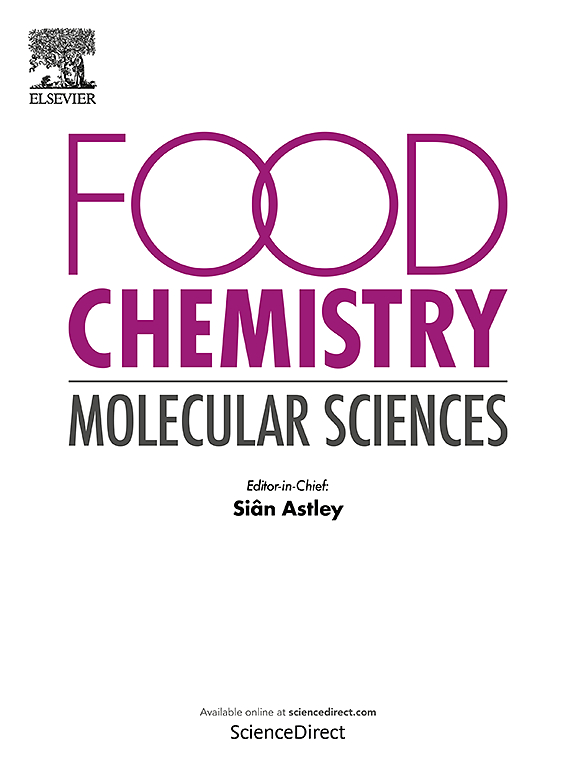Identification of S-1-propenyl-L-cysteine as the catalytic product of AfGGT1 and a key intermediate in isoalliin biosynthesis in Allium fistulosum. L
IF 4.1
Q2 FOOD SCIENCE & TECHNOLOGY
引用次数: 0
Abstract
Our findings reveal that pyruvic acid content is generally higher in Allium fistulosum than in A. cepa. In A. fistulosum, the bulbs contain more pyruvic acid than the leaves, while in A. cepa, the inner bulb layers exhibit higher levels compared to the outer layers. We demonstrate that A. fistulosum γ-glutamyl transpeptidase 1 (AfGGT1) catalyzes the production of S-1-propenyl-L-cysteine from γ-glutamyl-S-1-propenylcysteine, whereas AfGGT2 and AfGGT3 lack catalytic activity. In natural populations of A. fistulosum, AfGGT1 expression shows a strong positive correlation with pyruvic acid content (R2 = 0.6976). The optimal catalytic conditions for AfGGT1 are pH 7 and 37 °C, with a Km value of 0.2686 mM under these conditions. Molecular docking studies further reveal distinct substrate-binding conformations among AfGGT1, AfGGT2, and AfGGT3, highlighting functional divergence within the enzyme family.
s -1-丙烯- l-半胱氨酸作为AfGGT1催化产物和异蒜素合成关键中间体的鉴定。l
我们的研究结果表明,沙葱的丙酮酸含量普遍高于沙葱。赤竹的球茎比叶片含有更多的丙酮酸,而cepa的球茎内层比外层含有更多的丙酮酸。研究表明,A. fisstulosum γ-谷氨酰转肽酶1 (AfGGT1)可以催化γ-谷氨酰- s -1-丙烯半胱氨酸生成s -1-丙烯- l-半胱氨酸,而AfGGT2和AfGGT3缺乏催化活性。在天然居群中,AfGGT1表达量与丙酮酸含量呈极显著正相关(R2 = 0.6976)。AfGGT1的最佳催化条件为pH 7、37℃,Km值为0.2686 mM。分子对接研究进一步揭示了AfGGT1、AfGGT2和AfGGT3之间不同的底物结合构象,突出了酶家族内部的功能差异。
本文章由计算机程序翻译,如有差异,请以英文原文为准。
求助全文
约1分钟内获得全文
求助全文
来源期刊

Food Chemistry Molecular Sciences
Agricultural and Biological Sciences-Food Science
CiteScore
6.00
自引率
0.00%
发文量
83
审稿时长
82 days
期刊介绍:
Food Chemistry: Molecular Sciences is one of three companion journals to the highly respected Food Chemistry.
Food Chemistry: Molecular Sciences is an open access journal publishing research advancing the theory and practice of molecular sciences of foods.
The types of articles considered are original research articles, analytical methods, comprehensive reviews and commentaries.
Topics include:
Molecular sciences relating to major and minor components of food (nutrients and bioactives) and their physiological, sensory, flavour, and microbiological aspects; data must be sufficient to demonstrate relevance to foods and as consumed by humans
Changes in molecular composition or structure in foods occurring or induced during growth, distribution and processing (industrial or domestic) or as a result of human metabolism
Quality, safety, authenticity and traceability of foods and packaging materials
Valorisation of food waste arising from processing and exploitation of by-products
Molecular sciences of additives, contaminants including agro-chemicals, together with their metabolism, food fate and benefit: risk to human health
Novel analytical and computational (bioinformatics) methods related to foods as consumed, nutrients and bioactives, sensory, metabolic fate, and origins of foods. Articles must be concerned with new or novel methods or novel uses and must be applied to real-world samples to demonstrate robustness. Those dealing with significant improvements to existing methods or foods and commodities from different regions, and re-use of existing data will be considered, provided authors can establish sufficient originality.
 求助内容:
求助内容: 应助结果提醒方式:
应助结果提醒方式:


